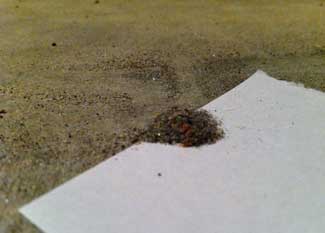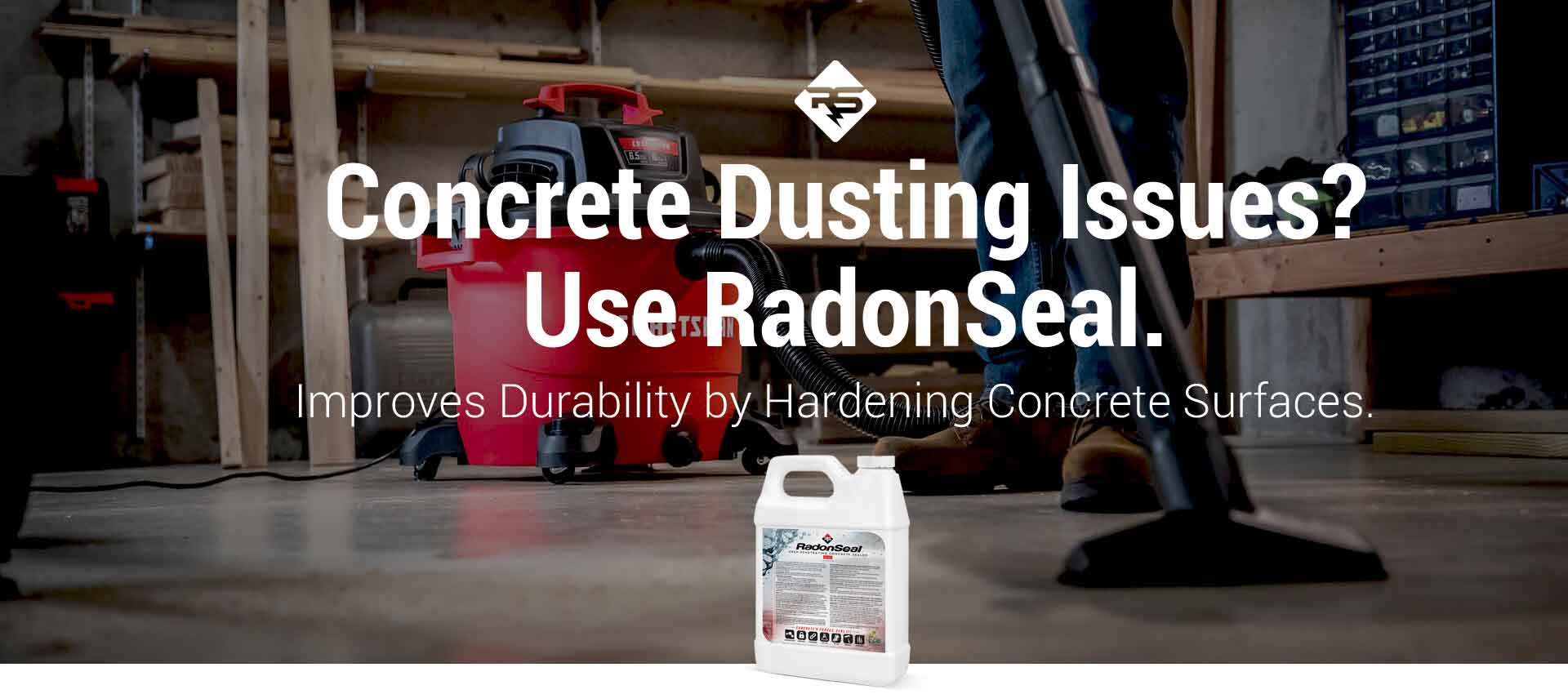Why Concrete Floors Start Dusting
If you want to prevent concrete dusting in your basement, garage, or workshop, it starts with understanding why concrete floors become dusty. When the top layer of untreated concrete breaks down, it releases a fine gray powder—commonly called concrete dusting—that settles on cars, tools, and storage boxes and lingers in the air you breathe.
While it may seem like a minor nuisance at first, concrete dusting can lead to bigger problems over time:
-
Constant mess – Dust coats floors, vehicles, and anything stored nearby.
-
Equipment and property wear – Fine particles can work into tools, electronics, and machinery.
-
Health concerns – Airborne concrete dust contains crystalline silica, which can irritate the lungs and cause long-term respiratory issues.
By learning how to prevent concrete dusting early, you can protect your home, your belongings, and your health—while keeping your concrete floors looking clean and lasting longer.
The Hidden Risks of Concrete Dusting
Once concrete floors begin to dust, it’s more than a cleaning hassle. Those fine gray particles can damage property and affect your health, making it even more important to prevent concrete dusting before it worsens.
1. HEALTH CONCERNS
The tiny particles released from untreated concrete often contain crystalline silica. Breathing in silica dust can:
-
-
Irritate the nose, throat, and lungs
-
Aggravate asthma or bronchitis
-
Lead to serious conditions like silicosis or lung cancer with long-term exposure
-
Children playing on basement floors are especially at risk because they are closer to the surface and inhale more dust.

2. PROPERTY & EQUIPMENT DAMAGE
Concrete dusting doesn’t just stay on the floor—it spreads everywhere:
-
-
Garages and workshops – Fine dust accelerates wear on tools and machinery
-
Storage areas – Dust coats boxes, vehicles, and electronics, making cleanup constant
-
Signs of slab deterioration – Severe dusting indicates your concrete is weakening over time
-
By understanding these risks, you can take steps to prevent concrete dusting permanently, protecting both your property and your family.
Why are My Concrete Floors Dusty?
Dusty concrete floors are usually a sign that the top layer of the slab is breaking down. As the surface weakens, it releases a fine gray powder—commonly called concrete dusting. This isn’t just a cleaning nuisance; it indicates that your floor needs attention before the damage worsens.
The most common causes of concrete dusting include:
-
Poor Surface Curing
-
Concrete that dries too quickly during installation forms a weak, powdery surface layer.
-
Proper curing allows the slab to gain full strength and resist surface wear.
-
-
High Water-to-Cement Ratio
-
Too much water in the mix carries fine particles and sand to the surface during the initial cure.
-
This friable, weak top layer easily grinds into dust under traffic.
-
-
Traffic and Abrasion
-
Foot traffic, vehicle tires, and dragging equipment grind down the surface.
-
Garages, basements, and workshops are especially prone to this type of wear.
-
-
Moisture Migration
-
Water moving through the concrete dissolves salts and weakens the surface.
-
Over time, this leads to visible dusting and gradual surface decay.
-
Key takeaway:
Dusty concrete floors are more than a housekeeping issue—they’re a warning sign of surface deterioration. Applying a penetrating concrete sealer is the best way to harden the slab, stop dusting, and prevent further damage.
How to Fix Dusting Concrete Floors
Once you understand the causes, the next step is learning how to prevent concrete dusting and protect your slab for the long term. There are two main approaches: surface coatings and penetrating concrete sealers.
1. PAINTS & COATINGS (Short-Term Fix)
Applying a paint, acrylic, urethane, or epoxy coating can temporarily stop dusting by covering the concrete surface. While this method works at first, there are some major drawbacks:
-
Limited lifespan—Coatings wear, scratch, and peel
-
Moisture trapping – Water vapor moving through the slab can cause bubbling and delamination.
-
Slippery finish – Creates a slick surface—unsafe for sidewalks, workshops, or pool decks.
- Frequent reapplication: Requires ongoing maintenance every few years.
Coatings only cover the symptom. Once the film fails, the dusting problem returns.
2. PENETRATING CONCRETE SEALERS (Permanent Solution)
A deep-penetrating concrete sealer, like RadonSeal®, is the most effective way to prevent concrete dusting permanently. Instead of forming a surface layer, it soaks into the pores of the slab and strengthens it from within.
How it works:
-
Penetrates deep into the pores of the concrete
-
Reacts chemically to harden and densify the surface
-
Seals against water, vapor, and abrasion from within
-
Invisible and non-slip, leaving the floor paintable and safe
By addressing the root cause—weak, porous concrete—a penetrating sealer ensures your floor remains dust-free, strong, and low-maintenance for years.
Step-by-Step: How to Seal a Concrete Floor to Prevent Dusting
Once you’ve identified the problem, the most effective way to prevent concrete dusting is to apply a deep-penetrating concrete sealer. Unlike surface coatings, penetrating sealers strengthen the slab internally, stopping dusting at its source.
Follow these simple steps for a permanent, dust-free concrete floor:
1. Clean the Floor Thoroughly
-
Sweep and vacuum to remove all loose dirt and concrete dust.
-
Use a concrete cleaner or degreaser to lift oils and residues that could block absorption.
-
Rinse and let the surface dry completely.
2. Ensure the Surface Is Dry
-
Moisture-free pores are essential for maximum sealer absorption.
-
If the slab feels damp or cold to the touch, allow more drying time.
-
A fan or dehumidifier can help in basements or humid spaces.
3. Apply a Penetrating Concrete Sealer
-
Use a pump-up sprayer or roller for fast, even coverage.
-
Work in sections to ensure consistent saturation.
-
The sealer will absorb into the concrete, leaving no surface film.
4. Allow the Sealer to Penetrate and Cure
-
Avoid traffic until the sealer has fully absorbed.
-
The chemical reaction hardens and densifies the concrete.
-
Once cured, your floor is dust-free, stronger, and moisture-resistant.
✅ Key Benefits of This Method:
-
Stops concrete dusting permanently
-
Strengthens and densifies weak or aging slabs
-
Keeps floors non-slip and easy to clean
-
Blocks water, vapor, and surface wear without a film
Why Prevention is Important
Concrete dusting isn’t just a cleaning headache—it’s a sign your floor is breaking down. Left untreated, the problem will continue to:
-
Release fine concrete dust into the air and onto your belongings
-
Increase health risks from inhaling crystalline silica particles
-
Accelerate wear on tools, vehicles, and equipment stored in your garage or shop
By sealing your floor with a deep-penetrating concrete sealer, you:
-
Stop concrete dusting permanently
-
Strengthen and densify the slab from within
-
Block water, vapor, and surface contaminants
-
Maintain a clean, non-slip, and low-maintenance surface for years to come
RadonSeal® Deep-Penetrating Concrete Sealer is the trusted choice for basements, garages, and workshops. Unlike paint or coatings, it works inside the concrete, creating a permanent, invisible shield against dusting, moisture, and deterioration.
👉 Order RadonSeal Concrete Sealer today and enjoy a cleaner, safer, dust-free concrete floor—permanently.
Concrete Dusting FAQ
Q1: Why is my concrete floor turning to dust?
Concrete floors become dusty when the surface layer weakens and breaks down—a process called concrete dusting. Common causes include poor curing, excess water in the mix, heavy traffic, and moisture migration. As the surface deteriorates, it releases fine gray dust containing crystalline silica.
Q2: How can I prevent concrete dusting permanently?
The most effective way to 🛡️ prevent concrete dusting is to apply a RadonSeal Deep-Penetrating Concrete Sealer. Unlike paint or epoxy coatings, RadonSeal will:
-
Soak into the pores of the slab
-
Harden and densify the surface permanently
-
Block moisture movement through the pores
This strengthens the concrete and stops dusting at its source.
Q3: Can epoxy or paint stop concrete dusting?
🎨 Epoxy, acrylic, or urethane coatings can temporarily reduce dusting, but they:
-
Wear or peel over time
-
Trap moisture, which can cause bubbling or delamination
-
Can become slippery in garages or workshops
For a permanent, non-slip solution, choose a penetrating concrete sealer.
Q4: Is concrete dust dangerous to breathe?
⚠️ Yes. Concrete dust contains crystalline silica, which can:
-
Irritate the nose, throat, and lungs
-
Aggravate asthma or bronchitis
-
Lead to silicosis or other long-term lung problems
Sealing your floor prevents dusting and helps protect your health.
